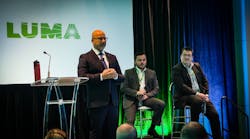Normal0falsefalsefalseEN-CAX-NONEX-NONE
In August the T&D World Supplement was focussed on LiDAR. That issue highlighted how technology continues to change VM.
Let’s go back in time and have look at the technology that has and is affecting the management of VM programs.
My history in utility VM goes back to 1975. For those of you who joined the workforce in the '90s or 2000s, you may find it difficult to envision how we did our work when we didn’t have cell phones, PCs or email. We didn’t even have fax machines, which are now becoming obsolete with email and the capabilities of today’s cell phones.
So, what technology has been a game changer?
Through my career, the first major development that came along was the statistical derivation of vegetation inventories. These provided a snapshot of utility vegetation conditions at a particular point in time. When combined with growth studies, utilities then had a means of basing funding requirements on actual, comprehensive field conditions. I would speculate that this was a logical extension of utilities increasingly hiring professional foresters to guide their VM programs: foresters who as a profession had resolved how to quantify what wood volumes would be available for cutting at specific points in time. The use of a statistical approach to vegetation inventories made feasible something that previously was prohibitively expensive. In the late '70s and early '80s, I believe ECI was the only deliverer of this service. This was a significant development because without a complete picture of the current conditions and growth rates, VM programs were typically underfunded and consequently chasing an ever-expanding need, represented by a logistic curve (to understand why see VM Funding). In Trees Grow on Money I stated “Senior management of TransAlta Utilities Corp. (TAU) Calgary, Alberta was highly dissatisfied with the fact that even though the distribution line clearance budget had been increased an average 35% a year between 1978 and 1984 there were few if any discernible positive results. Tree-related power outages kept increasing.” I believe, this was at the time, a rather common experience at utilities.
Another thing ECI brought to the industry was detailed data collection on work completed and a productivity measuring, evaluation system based on work presented by the late Bob Nosse. These systems were mainframe-based. Most utility VM work in the late '70s and early '80s was contracted based on time and materials. In addition to tracking work and units completed, this system provided a means of distinguishing which crews were most cost effective. TransAlta Utilities foresters extended this work by adding further financial considerations which showed that variations in effectiveness of up to 30% could not be discerned in the field. Not only did such a reporting system inform vegetation managers but the financial insight gained propelled the VM group into a leadership position within the utility and garnered credibility with senior management. There are now several reporting systems on the market and with time they have evolved to be even more comprehensive.
I would say first place for the greatest impact goes to the PC. It opened the door to spreadsheets, relational databases and email. Utility foresters make extensive use of spreadsheets and the attendant graphing capabilities. The use of relational databases is somewhat more esoteric, and generally their development would involve the use of the IT department. Since the 1990's the use of GIS has become common in utilities and the backbone of these systems is a relational database.
A personal anecdote regarding the use of the PC may serve to communicate the merits of this technology. In 1986 the TransAlta Utilities Distribution Line Clearance program was a subscriber to ECI’s Trim Report and Evaluation System. As the process of data collection and entry resulted in cost reporting that fell three to four weeks behind actuals, I developed a spreadsheet to bring costs up to the end of the previous week ending. I was using Lotus 123, version 1a, running on 64K Digital computer of which there was one in each of the seven Division offices. At the time, these sat idle. Not only did no one know the power they represented, no one knew even how to turn it on. Management was extremely appreciative when we brought in the budget of the largest O & M expense within ¼ of one percent. Other groups viewed us suspiciously. The prevailing sentiment appeared to be that our success was nothing more than a fluke, a stroke of luck or due to some, as yet undetected, form of trickery. Yet the following year you needed to book time on the Division PC and by the year after, PCs started popping up on the desks of individuals.

